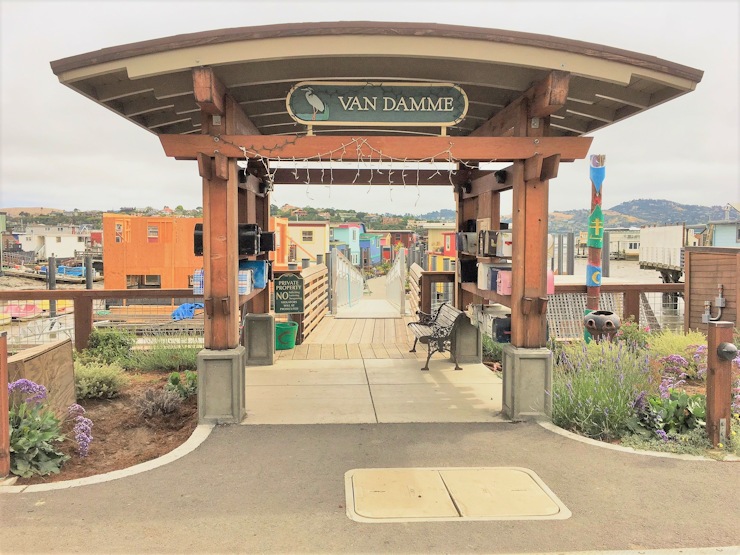
Recently we digested a recount of the convoluted development of Waldo Point Harbor from a talk given by Charles Bush, former attorney for the Gates Cooperative. Now we continue with a digest of Charle’s account of the evolution of the Gates Cooperative:
After two years of legal and physical skirmishes, in 1979 negotiations were finally initiated between WPH, Marin County, the group of nonconforming residents who called themselves the Gates Cooperative, (Co-op), and their financial backer, the San Francisco Foundation (SFF). These negotiations resulted in a plan to add 78 berths at Waldo Point for Gates Coop members. The BCDC and the State Lands Commission (which took over stewardship of this underwater real estate in 1938), were not involved in those negotiations, and eventually blocked the plan. So, the Co-op remained as an un-permitted subtenant of WPH.
One accomplishment that came out of the negotiations was to designate the old railroad right of way for Co-op parking. Using funds from the SFF and a Community Development Block Grant ( CDBG), in 1983 the County purchased a small strip of land from the Northwest Pacific Railroad, which had discontinued its train service. Because the land was above the mean high tide line, this transaction didn’t need permission from State Lands or the BCDC.
In the mid-80s, Waldo Point was replete with violations of the McAteer-Petris Act and public trust doctrine. Besides the presence of Gates Co-op boats not authorized in the permits, State Lands (SLC) declared that the encroachment of “boats on streets” was a violation of public trust.
WPH’s BCDC permit was due to expire in 1992, and the Commission wasn’t going to renew it if these violations weren’t eliminated. That put WPH in an impossible position, so the developers sued BCDC, SLC and the County. In return, WPH and the Co-op were countersued. After three years of legal hostilities, in 1991, the state agencies and WPH took litigation off the calendar and began negotiating with each other, excluding the Co-op and, for the most part, the County. A proposed settlement was announced in October 1991.
The core idea of this major conceptual breakthrough was to make property lines conform to where the boats were, rather than moving boats to conform to property lines. In other works, making legality conform to reality vs. trying to make reality conform to legality.
Despite approvals by the BCDC and SLC, the details of the proposed settlement made all the stakeholders unhappy. The Gates Co-op would be limited to only 20-22 berths. Those boats were to be clustered near the entrance to Main Dock, with existing WPH lessees being relocated outward on an extension of the dock. The WPH leaseholders, who had formed an advocacy alliance called Harbor Equity Group, complained about insufficient parking. One solution, transferring the railroad property from the Co-op to WPH, ran into a wall of opposition from the Co-op, the SFF and CDBG. Marin County joined the opposition and transferred the railroad property to the Ecumenical Association for Housing in 1992, in trust for the Co-op. By that point, the settlement agreement had completely fallen apart, leaving everyone angry.
In December 1992 the Co-op proposed to trade a substantial part of the railroad property to WPH in exchange for an increase in number of Co-op berths to 41. For the first time in history all the parties agreed to same proposal. From that point on, all that was left was to implement the agreement. That’s not to say everything was easy. Every parcel had to be surveyed and appraised. The state agencies drove a hard bargain, requiring WPH to purchase an underwater parcel in Mill Valley and deed it back to the state. Plus, WPH had to contribute to the development of Dunphy Park. It took twelve years after the conceptual approval in December 1992 to the approval of the final plan in 2004.
From 2014-2019 the Co-op was dismantled. Most of the surviving boats were moved onto the new Van Damme Dock between Issaquah and Main Docks, and into available spaces on Issaquah and A Docks. The resulting reconfiguration of Waldo Point was recognized with a Beautification Award from Sausalito Beautiful. Reality and legality have finally converged.